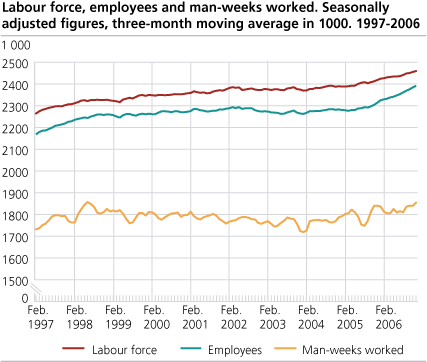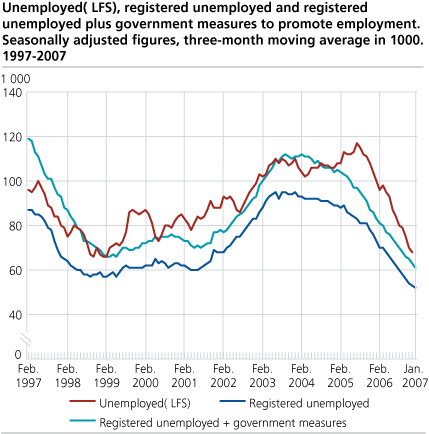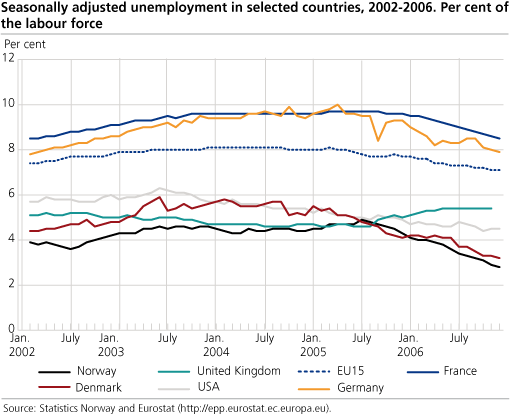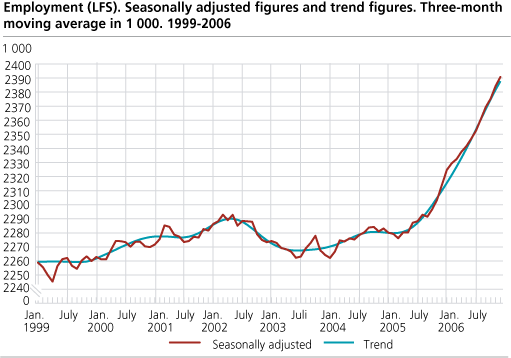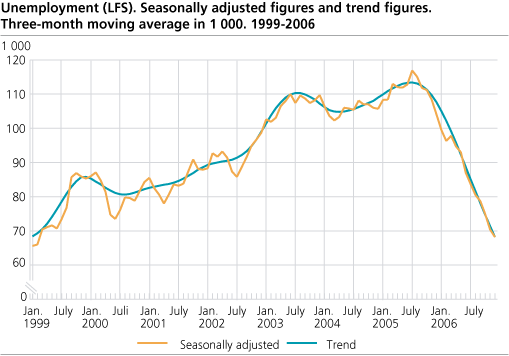Content
Published:
This is an archived release.
Continued fall in unemployment
From September to December 2006, the number of unemployed people fell by 10 000 according to new, seasonally adjusted figures from Statistics Norway's Labour Force Survey. The unemployment rate stood at 2.8 per cent in December, down from 3.2 per cent in September. The number of employed people increased by 21 000 in the same period.
Adjusted for seasonal variations, the number of employed people increased by 21 000 from September (as measured by the average of the three months from August to October) to December (as measured by the average of the three months from November to January). The upward trend in employment which began in the summer of 2005, thereby continued to the end of 2006. Adjusted for seasonal variations, the number of employed people increased by 104 000 from June 2005 to December 2006.
Unemployment rate at the same level as the previous low
The number of unemployed people fell by 10 000 from September (as measured by the average of the three months from August to October) to December (as measured by the average of the three months from November to January). This brought the unemployment rate down to 2.8 per cent, from 3.2 per cent in September. The unemployment rate peaked at 4.9 per cent in mid-2005, and has fallen steadily since. At 2.8 per cent, it is now at the same level as the previous low in early 1999.
Seasonally adjusted figures of people registered unemployed with the Labour and Welfare Organisation, show a decline of 5 000 from September to December.
Unemployment rate down in most EU Member States
From September to December, the unemployment rate fell in 16 of the 27 EU Member States. The unemployment rate for the EU15 fell from 7.2 to 7.1 per cent. Several large EU countries saw a decrease in unemployment during this period: In Germany, the unemployment rate fell from 8.5 to 7.9 per cent, and in France from 8.8 to 8.5 per cent. In the UK, the increase in unemployment appears to have levelled off. In Denmark, the unemployment rate fell from 3.5 to 3.2 per cent from September to December, following the downward trend that began in the autumn of 2004. The US also saw a decrease in unemployment, from 4.7 to 4.5 per cent. (All figures refer to seasonally adjusted data from Eurostat .)
Continued growth in man-weeks worked
From September (as measured by the average of the three months from August to October) to December (as measured by the average of the three months from November to January), the average number of man-weeks (37.5 hours) worked each week rose by 19 000. This is consistent with the growth in these figures since the beginning of 2004.
|
Uncertain figures
The purpose of making adjustments for seasonal variations is to describe the development over the last year and provide estimates of change between the last two three-month periods, corrected for normal seasonal variations. In order to reduce uncertainty, the published series are three-month moving averages of the seasonally adjusted figures. For instance, the figures for December represent the average of the estimates for November, December and January. Quarterly LFS figures, not seasonally adjusted, are presented in a separate article . |
Tables:
The statistics is published with Labour force survey.
Contact
-
Arbeidsmarked og lønn
E-mail: arbeidsmarked@ssb.no
-
Erik Herstad Horgen
E-mail: erik.horgen@ssb.no
tel.: (+47) 93 08 68 62

